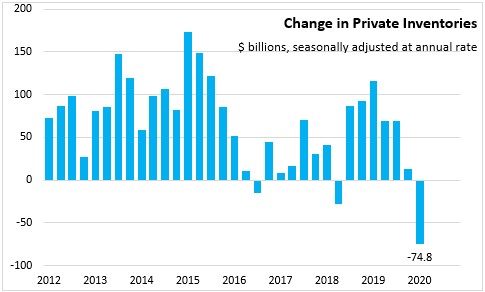The Economics and Statistics Division maintains archives of previous publications for accountability purposes, but makes no updates to keep these documents current with the latest data revisions from Statistics Canada. As a result, information in older documents may not be accurate. Please exercise caution when referring to older documents. For the latest information and historical data, please contact the individual listed to the right.
<--- Return to Archive
For additional information relating to this article, please contact:
June 25, 2020US GDP 2020 Q1 (THIRD ESTIMATE) 
The Bureau of Economic Analysis (BEA) released the first quarter of 2020 US Real Gross Domestic Product (GDP) “third” estimate today. In the third estimate, the US GDP decreased 5.0 per cent (seasonally adjusted annualized rate, chained 2012 dollars) in Q1 2020, unrevised from the second estimate. With the third estimate, an upward revision to non-residential fixed investment was offset by downward revisions to private inventory investment, personal consumption expenditures (PCE) and exports.
The decline in the third estimate of first quarter GDP reflected the response to the spread of COVID-19 as governments issued “stay at home” orders beginning in March 2020. This led to rapid changes in demand with businesses and schools switching to remote work arrangements and consumers restricting or redirecting their spending. However, the BEA states that the full economic effects of the COVID-19 pandemic cannot be quantified in the GDP estimate for the first quarter of 2020 because the impacts are generally embedded in source data and cannot be separately identified.
The decrease in real GDP in the first quarter reflected negative contributions from PCE, private inventory investment, non-residential fixed investment, and exports that were partly offset by positive contributions from residential fixed investment, federal government spending, and state and local government spending.


Personal consumption expenditure growth slowed with a decline of 6.8 per cent compared to an average of 3.2 per cent growth over the previous three quarters. The decrease in PCE reflected a decline in services, led by health care as well as food services and accommodations, and durable goods.
Non-residential investment decline was 6.4 per cent reflecting a decrease in equipment (-16.6%), led by transportation equipment. Non-residential structure spending increased 2.7 per cent, while residential investment increased 18.2 per cent. The decrease in private inventory investment was mainly in manufacturing, led by petroleum and coal products.
Exports declined 9.0 per cent reflecting a decrease in services exports (-21.1%) and goods exports (-2.0%). Imports declined 15.7 per cent.
Federal government nondefense spending increased by 3.3 per cent in Q1 while defense spending was up 1.1 per cent. Local state spending increased 0.6 per cent in the first quarter.
US nominal GDP (including the impacts of rising prices) decreased 3.4 per cent in Q1, compared to an increase of 3.5 per cent reported in the fourth quarter. The personal consumption expenditure price index increased 1.3 per cent, following a 1.4 per cent increase last quarter.
Source: US Bureau of Economic Analysis
<--- Return to Archive